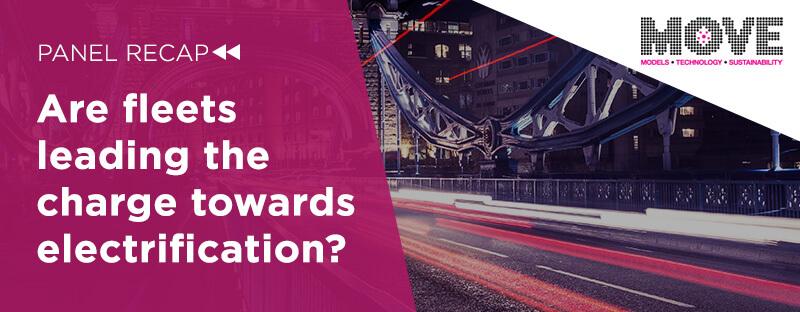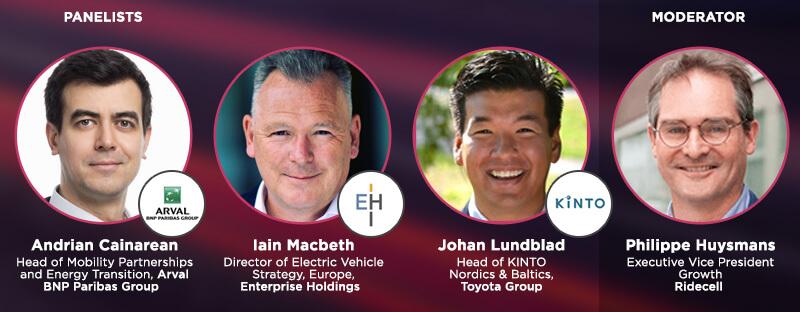
At the MOVE London conference on mobility, sustainability and the move to electrification and EVs was a hot topic. One of the highlights of the conference was a powerful discussion between Ridecell, Enterprise, Arval and Toyota representatives discussing their plans and challenges around the electrification of their fleets. The roundtable, led by Philippe Huysmans, EVP Growth at Ridecell provided insights that I’m excited to share with you.
Three industry leaders, each with a different vantage point to view the transition together, provided an insightful and thought-provoking perspective on what’s needed to fully embrace the transition to EVs.
Below, you’ll find highlights of unique perspectives from:
- Iain Macbeth, Director of Electric Vehicle Strategy, Europe, Enterprise Holdings
- Johan Lundblad, Head of KINTO Nordics & Baltics, Toyota Group
- Andrian Cainarean, Head of Mobility Partnerships and Energy Transition, Arval BNP Paribas Group

Ridecell Q: What are some of your current initiatives and specific targets relating to EVs and net zero?
Enterprise: We have a fleet of roughly 2 million vehicles globally. The challenge to electrify and transition to net zero is quite significant for a company of our scale, particularly when it comes to charging infrastructure.
The utilization rate of our fleet is about 90%, and typically one in four vehicles are being turned around within an hour—so we need rapid charging capabilities. We use third party infrastructure for the majority of our refueling, but we’re also having to electrify our branches (470 locations in the UK alone).
Arval: We want to help our customers in this energy transition journey, and we want to be the leading player in our industry when it comes to electrification. What does it mean in terms of numbers? Initially, we wanted 25% of our fleet electrified by 2025—that’s 500,000 electric vehicles.
Earlier this year, we revised that target to 700,000 because we see that the market is there. That market traction continues to grow, and we believe that we will be able to reach this new threshold.
KINTO: In 2020 during the pandemic, we went 100% fully hybrid-electric. Our approach includes multi-drivetrain technologies: hybrid, plug-in hybrid, battery electric, and hydrogen. We are striving to reach carbon neutrality while giving more options to consumers around the globe.
It’s critical that we focus on what our customers want. Because we live in a very diverse world, we have very unique circumstances that need diverse solutions. The hybrid vehicle has been a great way to quickly electrify our whole fleet, and the next step was to introduce plug-in hybrids. And, because we have the data on how customers have been using our cars, we knew they are not traveling far—an average of 70 kilometers—that can be met with a plug-in hybrid.

Ridecell Q: What are some of the driving forces behind widespread electrification?
Enterprise: It’s being driven by governments in many countries, from the very top level down; from the European Commission to local authorities and administrations. Many have already been implementing low and ultra-low emission zones.
And, of course, the customer is a huge driving factor. Customers are directly impacted financially by having to pay ultra-low emissions zone charges. OEMs are steadily increasing the availability of EV cars, and we’re beginning to see more democratization of availability. There’s obviously a cost imperative to purchasing a consumer EV, but we expect that the price parity of EVs versus other vehicles will equalize in 2025 or 2026.
Arval: There are four key categories/reasons that are driving fleet electrification.
- Customers that have an activity related to this industry—energy utility companies, for example.
- Companies that have a very strong commitment to corporate social responsibility, and are ready to pay a premium in some cases to make good on that commitment.
- Companies that have activities in cities or those that deliver goods in city centers need to be able to operate, even if it costs them 10% more.
- The most important category: those adopting for the total cost of ownership (TCO) benefits. Ultimately, this will be the main reason for mass electrification and the adoption of electric vehicles.
Ridecell Q: What do you think about hydrogen as another fuel alternative?
KINTO: Hydrogen is electrification, producing electricity to refuel the cell, and hydrogen vehicles reuse many of the components that are already in hybrid vehicles. We believe that in the future, hydrogen will be important for carbon neutrality.
If hydrogen can be a complimentary battery source in passenger cars, we could reduce pressure to create a massive infrastructure of plug-in only stations.
Arval: It’s becoming clear that electric mobility is the only way for us to reach zero emission targets, be it hydrogen, which indeed is an electric vehicle as well, or battery electric vehicles. I think that our role as an industry is to help our customers move as smoothly as possible into the future—and that future is electric.
Ridecell Q: Where do you see the EV industry headed?
Enterprise: We are in a transition stage. EVs are not the answer to all mobility issues, but I think shared mobility is certainly the way forward. As a company, we are going to help our customers transition, investing billions of euros and dollars into this process over the next few years.
KINTO: Fleets can lead the charge for a fast transition toward becoming fully decarbonized. Through a managed and shared fleet, we can provide more mobility to more users—rental car and full-service leasing models will provide similar results. That’s what we can achieve together, and it can really be a net-positive to creating better mobility while reducing the carbon footprint of the entire global transportation system.
Author: Mark Thomas, VP of Alliances and Marketing, Ridecell


